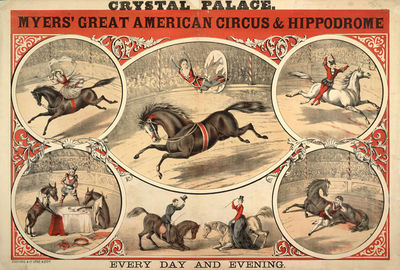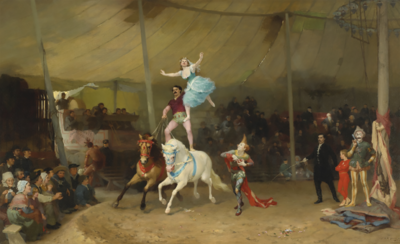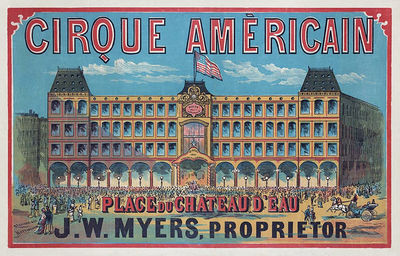Difference between revisions of "James Washington Myers"
From Circopedia
(→J.W. Myers’ Great American Circus) |
|||
| (4 intermediate revisions by the same user not shown) | |||
| Line 1: | Line 1: | ||
| − | [[File: | + | [[File:Myers'_Great_American_Circus_%26_Hippodrome_(1876).jpeg|right|400px]] |
==Equestrian, Acrobat, Clown, Circus Owner== | ==Equestrian, Acrobat, Clown, Circus Owner== | ||
| Line 15: | Line 15: | ||
===European Travels=== | ===European Travels=== | ||
| − | + | This experience may not have been as successful as intended: In 1857, Jim rejoined Seth B. Howes as a performer, and went with Howes & Cushing Circus (owned by Seth B. Howes and [[Joseph Cushing]]) on to a tour of Great Britain, along with thirteen-year-old Rose Madigan—whom Myers would later marry in England. Advertised either as ''Great United-States Circus'' or ''Great American Circus'', Howes & Cushing Circus was extremely successful in England and Scotland, fending off profitably a fierce competition with the English circus king, [["Lord" John Sanger]]. | |
| − | In 1858, they had a lucrative run in London at the Alhambra Palace on Leicester Square—the former Royal Panopticon of Science and Art, which had just been converted into a circus. (The building, which later became a fabled variety theater, is now a multiplex movie-house.) On May 22, Queen Victoria, who couldn’t resist a good circus show, paid a visit with Prince Albert to the Great American Circus at the Alhambra, thus insuring its continuing success. Indeed, the Queen was pleased: In June, the troupe was invited to a repeat performance at Windsor Castle. | + | [[File:Myers_Circus.png|thumb|left|400px|Myers' American Circus performing under canvas in France (c.1869)]]In 1858, they had a lucrative run in London at the Alhambra Palace on Leicester Square—the former Royal Panopticon of Science and Art, which had just been converted into a circus. (The building, which later became a fabled variety theater, is now a multiplex movie-house.) On May 22, Queen Victoria, who couldn’t resist a good circus show, paid a visit with Prince Albert to the Great American Circus at the Alhambra, thus insuring its continuing success. Indeed, the Queen was pleased: In June, the troupe was invited to a repeat performance at Windsor Castle. |
It is while he was in England that Jim Myers is said to have been the first acrobat to turn a double somersault from a "batoude" over a group of horses. Howes and Cushing ended their run at the Alhambra at the end of 1858, but their circus remained in Great Britain until 1864, when it finally returned to America. Jim Myers, however, didn’t stay with Howes & Cushing Circus after the Alhambra engagement, and didn’t return either to the United States. Instead, he formed his own company, ''J.W. Myers’ Great American Circus'', with which he continued to tour Britain and eventually invaded the Old Continent. | It is while he was in England that Jim Myers is said to have been the first acrobat to turn a double somersault from a "batoude" over a group of horses. Howes and Cushing ended their run at the Alhambra at the end of 1858, but their circus remained in Great Britain until 1864, when it finally returned to America. Jim Myers, however, didn’t stay with Howes & Cushing Circus after the Alhambra engagement, and didn’t return either to the United States. Instead, he formed his own company, ''J.W. Myers’ Great American Circus'', with which he continued to tour Britain and eventually invaded the Old Continent. | ||
| Line 27: | Line 27: | ||
Jim Myers and his circus traveled extensively in England and France (which he began touring in 1867), and visited Switzerland (1866), made a foray in Egypt (1868) with [[Les Fratellini|Gustave Fratellini]] in his cast, and continued his European tours in Italy (1872), Germany, Austria, Belgium and The Netherlands (1873), and possibly other European countries. In 1875, Myers leased the courtyard of the Magasins Réunis, a large department store located Place du Château d’Eau in Paris (today Place de la République), where he built a permanent wooden circus construction.(The Magasins Réunis building is extent, and is occupied today by the Crowne Plaza Hotel.) | Jim Myers and his circus traveled extensively in England and France (which he began touring in 1867), and visited Switzerland (1866), made a foray in Egypt (1868) with [[Les Fratellini|Gustave Fratellini]] in his cast, and continued his European tours in Italy (1872), Germany, Austria, Belgium and The Netherlands (1873), and possibly other European countries. In 1875, Myers leased the courtyard of the Magasins Réunis, a large department store located Place du Château d’Eau in Paris (today Place de la République), where he built a permanent wooden circus construction.(The Magasins Réunis building is extent, and is occupied today by the Crowne Plaza Hotel.) | ||
| − | [[File: | + | [[File:Myers_Cirque_Américain_(1876).jpeg|thumb|right|400px|Myers' Cirque Américain in Paris (1876)]]Paris’s ''Cirque Américain'' became Jim Myers’s French base, and remained more or less active until 1879. Paris was not an easy territory: Myers had to contend with well-established local competition: The [[Cirque d'Hiver]], which was just a few blocks away; the [[Cirque des Champs Elysées]] (in the summer); the newly built and already popular [[Cirque Fernando]] in Montmartre; and the mighty [[Hippodrome de l'Alma]], which opened its doors in 1877 and was an even bigger threat. Changing programs every two weeks or so, as the competition was doing, was not an easy task for someone who was not very well acquainted with the Parisian show business—and no doubt, his competitors didn't try to make it easier for him! |
Thus, following the Parisian custom, the programs presented by Myers in his Parisian circus in 1876 changed regularly. Rose Myers rode in haute-école, [[The Madigan Family|Charles Madigan]], Jim’s brother-in-law, presented the circus’s horses "at liberty," and Charles’s brother [[The Madigan Family|James]] was the Equestrian Director: It was indeed a family affair, but Myers also hired a host of well-known artists, among whom the celebrated clowns, the [[Olschansky Family|Olschansky Brothers]]. The performances ended, in good Parisian fashion, with a pantomime—such as ''Le petit chaperon rouge'' ("Little Red Riding Hood"), the climax of which was the "capture" of a real wolf. | Thus, following the Parisian custom, the programs presented by Myers in his Parisian circus in 1876 changed regularly. Rose Myers rode in haute-école, [[The Madigan Family|Charles Madigan]], Jim’s brother-in-law, presented the circus’s horses "at liberty," and Charles’s brother [[The Madigan Family|James]] was the Equestrian Director: It was indeed a family affair, but Myers also hired a host of well-known artists, among whom the celebrated clowns, the [[Olschansky Family|Olschansky Brothers]]. The performances ended, in good Parisian fashion, with a pantomime—such as ''Le petit chaperon rouge'' ("Little Red Riding Hood"), the climax of which was the "capture" of a real wolf. | ||
| Line 44: | Line 44: | ||
<Gallery> | <Gallery> | ||
File:Myers_Cirque_Américain_Tour_1869.jpeg|Poster for Myers' Grand Cirque Américain (1869) | File:Myers_Cirque_Américain_Tour_1869.jpeg|Poster for Myers' Grand Cirque Américain (1869) | ||
| + | File:Myers_Circus.png|The Cirque Américain touring in Brittany (c.1869) | ||
File:Myers_Grosse_Amerikanischer_Circus_(1873).jpeg|Poster for Myers' Grosser Amerikanischer Circus in Dresden (1873) | File:Myers_Grosse_Amerikanischer_Circus_(1873).jpeg|Poster for Myers' Grosser Amerikanischer Circus in Dresden (1873) | ||
File:Myers_Prince_de_Galles_(1875).jpeg|Pantomime at Myers' Cirque Américain in Paris (1875) | File:Myers_Prince_de_Galles_(1875).jpeg|Pantomime at Myers' Cirque Américain in Paris (1875) | ||
Latest revision as of 19:55, 1 February 2020
Equestrian, Acrobat, Clown, Circus Owner
By Dominique Jando
Jim Myers (1823-1892) was an American equestrian and circus entrepreneur who began his career in the United States, went on to perform in Great Britain and subsequently became a very successful circus impresario in Europe—where the Great American Circus he created there toured extensively, and where he even established a resident circus in Paris.
Born James Washington Myers in Providence, Rhode Island in 1823, he was apprenticed at the tender age of nine to the equestrian and showman Aaron Turner (1790-1854). Like many young performers of that period, he adopted his teacher’s name when he debuted in the ring, and was billed for a time as a bareback rider and acrobat under the name of James Turner. By 1845, however, he had reverted to his own identity and, as Jim Myers, presented equestrian scenes in the manner of Andrew Ducrow in his mentor’s circus.
But Myers was an ambitious and enterprising young man, and in 1854, he entered a partnership with Henry P. Madigan (1815-1862), a fellow equestrian who had worked with him for Aaron Turner, and together they created the Myers & Madigan’s Railroad Circus. Myers worked as a clown in their show; he would later marry his partner’s daughter, Rose Madigan (1839-1907), a talented equestrienneA female equestrian, or horse trainer, horse presenter, or acrobat on horseback. in her own right, who was sixteen years his junior.
The Myers & Madigan Railroad Circus, which was one of the earliest circuses traveling by rail, became Howes Menagerie and Myers & Madigan Circus in 1855, when the partners entered an association with Seth B. Howes (1815-1901)—himself a pioneer of the American traveling circus and a former associate of Aaron Turner. This combine was short-lived however, and the following year, Myers went on the road without partners, with his own Jim Myers’ Circus.
European Travels
This experience may not have been as successful as intended: In 1857, Jim rejoined Seth B. Howes as a performer, and went with Howes & Cushing Circus (owned by Seth B. Howes and Joseph Cushing) on to a tour of Great Britain, along with thirteen-year-old Rose Madigan—whom Myers would later marry in England. Advertised either as Great United-States Circus or Great American Circus, Howes & Cushing Circus was extremely successful in England and Scotland, fending off profitably a fierce competition with the English circus king, "Lord" John Sanger.
In 1858, they had a lucrative run in London at the Alhambra Palace on Leicester Square—the former Royal Panopticon of Science and Art, which had just been converted into a circus. (The building, which later became a fabled variety theater, is now a multiplex movie-house.) On May 22, Queen Victoria, who couldn’t resist a good circus show, paid a visit with Prince Albert to the Great American Circus at the Alhambra, thus insuring its continuing success. Indeed, the Queen was pleased: In June, the troupe was invited to a repeat performance at Windsor Castle.It is while he was in England that Jim Myers is said to have been the first acrobat to turn a double somersault from a "batoude(French) A long wooden tramplin that acrobats use to jump over other performers, horses, or elephants, notably in the charivari. Also called "grande batoude"." over a group of horses. Howes and Cushing ended their run at the Alhambra at the end of 1858, but their circus remained in Great Britain until 1864, when it finally returned to America. Jim Myers, however, didn’t stay with Howes & Cushing Circus after the Alhambra engagement, and didn’t return either to the United States. Instead, he formed his own company, J.W. Myers’ Great American Circus, with which he continued to tour Britain and eventually invaded the Old Continent.
In England, Myers acquired two elephants and a group of seven lions, which were presented by the talented English wild animal trainer John Cooper. He later purchased four more elephants: The group became the first large elephant herd presented in Europe, where trainers used to work with a single specimen, or two at most. The herd had reached eight trunks by 1876; it was indeed an impressive sight to Myers’s European audiences, and no doubt, it was an important part of the American showman’s success in Europe. (When Myers sold his show in 1882, the group had been reduced to four animals.)
J.W. Myers’ Great American Circus
Jim Myers and his circus traveled extensively in England and France (which he began touring in 1867), and visited Switzerland (1866), made a foray in Egypt (1868) with Gustave Fratellini in his cast, and continued his European tours in Italy (1872), Germany, Austria, Belgium and The Netherlands (1873), and possibly other European countries. In 1875, Myers leased the courtyard of the Magasins Réunis, a large department store located Place du Château d’Eau in Paris (today Place de la République), where he built a permanent wooden circus construction(French) A temporary circus building, originally made of wood and canvas, and later, of steel elements supporting a canvas top and wooden wall. Also known as a "semi-construction.".(The Magasins Réunis building is extent, and is occupied today by the Crowne Plaza Hotel.)
Paris’s Cirque Américain became Jim Myers’s French base, and remained more or less active until 1879. Paris was not an easy territory: Myers had to contend with well-established local competition: The Cirque d'Hiver, which was just a few blocks away; the Cirque des Champs Elysées (in the summer); the newly built and already popular Cirque Fernando in Montmartre; and the mighty Hippodrome de l'Alma, which opened its doors in 1877 and was an even bigger threat. Changing programs every two weeks or so, as the competition was doing, was not an easy task for someone who was not very well acquainted with the Parisian show business—and no doubt, his competitors didn't try to make it easier for him!Thus, following the Parisian custom, the programs presented by Myers in his Parisian circus in 1876 changed regularly. Rose Myers rode in haute-école(French) A display of equestrian dressage by a rider mounting a horse and leading it into classic moves and steps. (See also: High School), Charles Madigan, Jim’s brother-in-law, presented the circus’s horses "at liberty"Liberty act", "Horses at liberty": Unmounted horses presented from the center of the ring by an equestrian directing his charges with his voice, body movements, and signals from a ''chambrière'' (French), or long whip.," and Charles’s brother James was the Equestrian Director: It was indeed a family affair, but Myers also hired a host of well-known artists, among whom the celebrated clowns, the Olschansky Brothers. The performances ended, in good Parisian fashion, with a pantomimeA circus play, not necessarily mute, with a dramatic story-line (a regular feature in 18th and 19th century circus performances).—such as Le petit chaperon rouge ("Little Red Riding Hood"), the climax of which was the "capture" of a real wolf.
Yet if Myers's group of eight elephants certainly impressed his audiences at the beginning of his first season, it is unlikely that his pantomimes were produced with the luxury with which the Cirque d'Hiver used to lavish his audiences, or with the Parisian wit of Cirque Fernando's productions, whose star was the popular clown Geronimo Medrano. Running an urban circus, with its constant hunt for talent and novelty, was not Myers's forte, and the documents pertaining to his Parisian circus after 1876 are scarce: It is possible that his subsequent seasons were just a halt in the middle of his tours. However, he rented his building to visiting circus companies such as the Cirque Cotrelli in the spring of 1877, and the Cirque Milanais in the spring of 1878 (which could have been one and the same), while himself continued his tours in the French provinces and beyond.
It is also possible that Myers’s traveling circus continued its tours during the 1876 Parisian season: Cooper, his lions, and his elephants are mentioned only once in Myers's Parisian programs, and they were too precious (and expensive) a trump card to have remained idle. The Madigans could have taken care of the Parisian base while The Great American Circus crisscrossed the Continent. Myers' Great American Circus also returned regularly to England, which was still its base (even some of Myers's French posters were printed in England). The Circus performed in London at least twice: at the Crystal Palace at Sydenham in 1876, and at the Royal Agricultural Hall (today the Design Business Centre) in Islington, in January of 1879.
Epilogue
If business appears to have been relatively good in general, it had not always been easy. Court documents show that Myers had many creditors, some of whom initiated lawsuits to recover their money. Show business has always been unpredictable, and Myers’s adventure came to an end on October 18, 1882, when he sold his horses, elephants, lions, and his circus equipment at the Royal Pavilion Gardens in North Woolwich, London—a popular Victorian amusement place. The sale brought him about £5,000, or half-a-million U.S. dollars in today’s money; Myers’s four remaining elephants fetched just a little more than £1,000.
Myers’ Great American Circus certainly had a significant impact on the European circus scene for nearly two decades, but its sale didn’t make Jim Myers a rich man; it probably served for the most part to pay his debts. Indeed, Myers couldn’t afford to retire: He went on to work with Hengler’s Circus in Great Britain, and remained there until his death at Bristol, on December 1, 1892, aged sixty-nine; his widow, Rose, passed away in England on April 28, 1907. They had two children: Ida, who worked as an equestrienneA female equestrian, or horse trainer, horse presenter, or acrobat on horseback. in her father’s circus, and James Washington, Jr., who worked at Hengler’s Circus, and embarked on a circus career as an acrobat and bareback rider that lasted at least until the first decade of the 20th Century.












